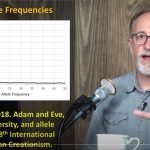[Originally published as part of 3 Reasons I Believe Jesus was Young Earth Creationist]
I think if we can show that Christ held a particular view about an issue, we have pretty strong evidence that we’re thinking correctly about it. I’d like to offer what I find to be convincing evidence that Jesus held a particular view of the age of the earth, even if he did not directly comment on it.
The Foundation for Marriage
The doctrine of marriage is certainly a central teaching of the Bible and something God is very concerned with. Above, we noted that Jesus’ most explicit teaching on the doctrine of marriage comes from Mark 10:6:
But from the beginning of the creation God made them male and female.
And its parallel passage, Matthew 19:4:
And he answered and said unto them, Have ye not read, that he which made them at the beginning made them male and female.
It’s important to note that Jesus is taking this teaching directly from statements made in Genesis chapters one and two — chapters that establish our understanding of the doctrine of creation and the doctrine of man, amongst other things. Now, we’ve discussed the textual reasons to think that Jesus means to say that male and female were created “in” the beginning — not 14 billion years after the initial creation event, but six literal days.
We’ll now look at the theological “why” behind this understanding. In other words, there are good theological reasons to think that the doctrine of marriage affirmed by Jesus here is problematic for the old age view.
In his book Faith, Form, and Time, Dr. Kurt Wise writes the following:
According to Scripture, God established marriage by creating man first, then woman from him. The divine origin of marriage justifies its permanence in God’s eyes (Matt. 19:3-9) and explains why the husband is established as the head of the wife (1 Cor. 11:3-10). If old-age chronology is true, Adam and Eve (if they ever did exist) would seem to have been derived from a population of reproducing apes. The acceptance of old-age chronology would require a substantial revision of the Christian doctrine of marriage.
[Note: An assumption made in the above statement is that old age chronology necessitates taking an evolutionary position, even though this is not necessarily true within Christian circles. What Dr. Wise would want to argue in response, I believe, is that evidence for the theory of evolution is well-enough attested and in line with old age chronology that the only reasonable inference if you accept one is to accept the other. There are many good reasons for thinking that non-evolutionary old age chronology, as promulgated by organizations like Reasons to Believe (RTB), is unable to solve the contradictions, some of which can be easily seen and inferred from the forthcoming data—even if not explicitly stated.]
Dr. Wise states the issue in succinct form; however, it’d be a worthy exercise to build a cumulative case¹ highlighting the contradictions between statements in Scripture and the central dogma of evolution theory (and certain claims of old age chronology in general):
If Evolution is True, Jesus is Wrong About Creation
Since Jesus takes his teaching on marriage directly from both Genesis 1 and Genesis 2, it suggests that Jesus understood these to be literal, factual accounts. (Would Jesus base one of the most important doctrines found in Scripture — marriage — on myth?) And, since Jesus understands these to be factual accounts of history, the most reasonable method of understanding these passages is according to history — ancient history, to be specific. But when one takes this approach — the historical-grammatical approach — to understanding Scripture, one hardly arrives at any conclusions matching that of evolutionary suggestions.
For example:
Genesis 1 seems to suggest that the earth was created before the sun. But old age chronology (evolutionary or otherwise) requires that the sun had to have been created before the earth. Suggestions, of course, have been made to alleviate this problem, but none of them hold up to rigorous exegesis.² Furthermore, the only ones that might be convincing exegetically require presuppositions about the nature of Genesis that are foreign to Jesus’ thoughts about it (i.e., we couldn’t use the historical-grammatical hermeneutic), making acceptance of them nothing more than circular reasoning.
In the Genesis account, we find that flying animals were created before land animals, and plants were created before any animals. In old age chronology, however, we find the exact reverse to be the case.
Critical scholars (and even many who profess to be evangelical) tend to regard Genesis 2 as a sort of “second” creation account in contradiction with Genesis 1. But since Jesus quotes both in basically the same breath during his conversation with the Pharisees, this suggests that he takes the accounts to be complementary, rather than contradictory.
Old age chronology requires that animals have been carnivorous for millions of years before God’s creation of Adam. But Genesis 1 — which Jesus has affirmed to be historical by basing his doctrine of marriage on it — suggests that animals were created as herbivorous creatures (see Genesis 1:29-30). Strangely, Dr. Hugh Ross (the highly respected figurehead behind the RTB organization) wants to affirm that humans were herbivorous per Genesis 1:29, but in the very next breath, wants to deny that animals were herbivorous despite the fact that the next verse—Genesis 1:30—affirms it.³
The clearest reading of Genesis 3 suggests that thorns and thistles found in the fossil record are a direct result of the curse God places on the ground because of Adam’s sin. But old age chronology requires thorns and thistles millions of years down in the fossil record before the arrival of humans.
Are we to accept that Jesus thought Genesis 1 and 2 should be understood literally4 and worthy of teaching accurate doctrine, but Genesis 3 must be made non-literal in order to avoid being factually incorrect? Once we head down that road, does the Fall itself become non-literal and perhaps factually incorrect?
Genesis 2 recounts Adam naming all of the land animals and birds. However, if old age chronology is true, there are an estimated 50 billion extinct organisms (representing at least 250,000 species) that Adam never had the chance to name.
Finally, in the Noachian Flood account of Genesis 6-9 (another historical event affirmed by Jesus in Matthew 24:37), we find that all land animals at the time had a representative on the ark, but again, this can’t be true on old age theory since the above point notes the existence of hundreds of thousands of species that would not have been on there.5
Perspicuity requires that we take Jesus consistently, lest we find ourselves lost in a sea of confusion, unsure of what the Bible actually intends to teach. And when we do so, it hardly seems plausible that Jesus would speak so confidently of, and form doctrine by, his understanding of the role of humanity in Genesis 1 and 2 and at the same time deny these other teachings from the same passages and portions of Scripture which are stated with equal lucidity.
Footnotes
- This case will be largely based on information given by Dr. Kurt Wise, as he is considered an honest and reliable source by those on both sides of the origins debate. Much can be found in his book mentioned above, and much of the below is adapted from a lecture which can be viewed here.
- Sarfati, though I must disagree with his unnecessarily disparaging language, is helpful on this point: “Some assert that what really happened on this fourth “day” was that the sun and other heavenly bodies “appeared” when a dense cloud layer dissipated after millions of years. This is not only fanciful science but bad exegesis of Hebrew. The word ‘asah means “make” throughout Genesis 1, and is sometimes used interchangeably with “create” (bara’) — for example, in Genesis 1: 26– 27. It is pure desperation to apply a different meaning to the same word in the same grammatical construction in the same passage, just to fit in with atheistic evolutionary ideas like the big bang. If God had meant “appeared”, then He presumably would have used the Hebrew word for appear (ra’ah), as He did when He said that the dry land “appeared” as the waters gathered in one place on day 3 (Gen. 1: 9). We have checked over 20 major translations, and all clearly teach that the sun, moon, and stars were made on the fourth day.” (Sarfati, Refuting Compromise, Kindle locations 5548–5566. Emphasis in the original.)
- For support for this claim, see Sarfati, Refuting Compromise







